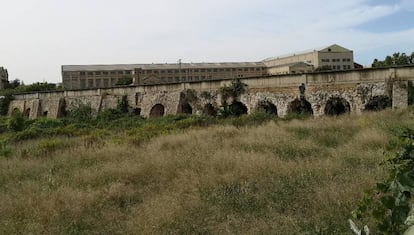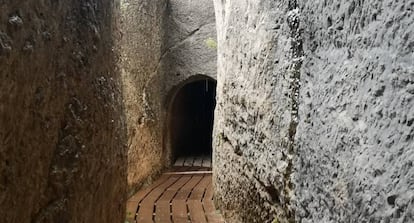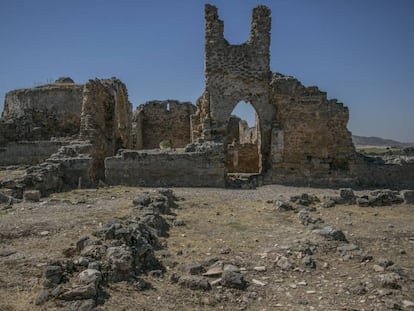One of the world’s longest Roman aqueducts was in Valencia, scholars discover
Although only a few sections have survived, this feat of engineering covered 98.6 kilometers between the mountains and the regional capital


In the year 1538, the Valencian historian Pere Antoni Beuter wondered which towns were once supplied by the impressive Peña Cortada aqueduct that cut through the Valencian towns of Chelva, Calles, Domeño and Tuéjar. Experts from the era, and many who came later, also spent time debating whether the aqueduct had ever worked in the first place.
Five centuries later, an archaeologist from the Polytechnic University of Valencia, Miquel R. Martí Maties, addressed the issue at the 6th International Congress of Roman Engineering held in Santo Domingo de la Calzada, in La Rioja. At the symposium, this expert revealed that these surviving sections once belonged to the longest aqueduct built on the Iberian Peninsula in Roman times.

The civil engineering feat covered 98.6 kilometers, beginning at a spring in the mountains of Valencia, in Tuéjar, at an altitude of 585 meters, and ending in what is today the center of the city of Valencia, on the Mediterranean coast. In other words, the medieval waterwheels and irrigation channels that can be seen in the Valencian countryside are an adaptation of what had been designed by Rome.
Built in the 1st century AD, the infrastructure was originally 93 kilometers long with stretches of it built on unstable terrain. There were leaks that caused it to collapse in what is now the municipality of Chelva, leaving a cliff face that is known as the Devil’s Balcony.
At that point, the Roman engineers decided to reroute, taking out 6.4 kilometers of the original design and adding another 12 that were built on more geologically stable terrain, giving the aqueduct a final length of 98.6 kilometers.
The Valencian aqueduct is the sixth longest from Roman times, ahead of Aqua Marcia in Italy (91 kilometers) or the Eifel in Cologne (95 kilometers) and 23 kilometers longer than the one in Cádiz.
The Valencian aqueduct is the sixth longest from Roman times, ahead of Aqua Marcia in Italy or the Eifel in Cologne
Archaeologists have come across inscriptions that, according to Martí Maties, allow us to read the names of those whose Roman villas were supplied with water from the aqueduct via pipes and covered channels.
The aqueduct did not only collapse in Chelva, however. “Those eliminated stretches led people to think that it was never completed, prompting some to come up with fanciful explanations for this,” says the archaeologist. In Gestalgar, for example, where the Calicantos aqueduct is located, both small and huge rock fragments would become dislodged – something that still happens today – which must have traumatized those in the vicinity when the aqueduct was in full use.
With the fall of the Roman Empire, the infrastructure became too costly to maintain. Consequently, entire stretches were cut out, though the section between Vilamarxant and the city of Valencia continued to function. This meant the water would no longer come from the original Tuéjar spring, but directly from the Turia river. “It led to fewer technical and economic problems, while the sloping terrain provided the gravity for the water’s course,” says Martí Maties.
With the fall of the Roman Empire, the infrastructure became too costly to maintain
By the 6th century AD, Valencia had recovered economically and socially from a crisis and a new kind of architecture emerged. The Byzantines, who were seeking cereals for Constantinople, rebuilt the Valencian aqueduct with the collaboration of the city’s elite. And a few kilometers inland, a Hispanic-Byzantine city was built which they called Valencia la Vella – now Ribarroja del Turia, complete with city walls and towers. Valencia la Vella would later be conquered by the Visigoth King Leovigild and supplied with water from the Vilamarxant stretch of aqueduct.
Under Moorish rule, Valencia once again became the capital and, in the 9th century, the Rovella aqueduct, which was a refurbished version of the original Roman structure, entered the capital directly. “The difference between Roman hydraulics, which were especially designed for human consumption, and Islamic hydraulics is the difference between a nice thick electricity cable and illegal outlets using small cables,” says Martí Maties. “Whether or not they used the original Roman structure, the Muslim canals followed the route designed by Rome. So the Arabs did not invent the Hispanic irrigation system that the Roman agronomist Columella had already spoken about, nor the waterwheels, which were Greek. Rome was the pioneer, as demonstrated by the existence of the aqueduct, which was subsequently adapted by the Byzantines and Visigoths and later by the Arabs and Christians.”
Hidden treasure
Urban development in the province of Valencia has gradually obscured the great Roman aqueduct. The construction of the Loriguilla reservoir in 1965, near the Chera-Sot de Chera Natural Park, submerged the remains of that particular tract.
But using aerial photos taken by the US army in 1956, Miquel Martí Maties has managed to trace its original path. Despite all the modern construction, the aqueduct is visible between the towns of Tuéjar and Domeño, accounting for 28.6 kilometers of the structure. And there are another 26 kilometers, albeit with gaps, between Vilamarxant and Valencia, as well as 700 meters in Gestalgar, which are joined by another kilometer and a half, built into a tunnel, between Gestalgar and Chulilla.
The original aqueduct entered the city of Valencia at the same place as the current Robella canal. It went to Tossal square from what is now the Casa de la Misericordia, from which point it supplied the entire city with water.
English version by Heather Galloway.
Tu suscripción se está usando en otro dispositivo
¿Quieres añadir otro usuario a tu suscripción?
Si continúas leyendo en este dispositivo, no se podrá leer en el otro.
FlechaTu suscripción se está usando en otro dispositivo y solo puedes acceder a EL PAÍS desde un dispositivo a la vez.
Si quieres compartir tu cuenta, cambia tu suscripción a la modalidad Premium, así podrás añadir otro usuario. Cada uno accederá con su propia cuenta de email, lo que os permitirá personalizar vuestra experiencia en EL PAÍS.
¿Tienes una suscripción de empresa? Accede aquí para contratar más cuentas.
En el caso de no saber quién está usando tu cuenta, te recomendamos cambiar tu contraseña aquí.
Si decides continuar compartiendo tu cuenta, este mensaje se mostrará en tu dispositivo y en el de la otra persona que está usando tu cuenta de forma indefinida, afectando a tu experiencia de lectura. Puedes consultar aquí los términos y condiciones de la suscripción digital.
More information
Últimas noticias
Most viewed
- Sinaloa Cartel war is taking its toll on Los Chapitos
- Oona Chaplin: ‘I told James Cameron that I was living in a treehouse and starting a permaculture project with a friend’
- Reinhard Genzel, Nobel laureate in physics: ‘One-minute videos will never give you the truth’
- Why the price of coffee has skyrocketed: from Brazilian plantations to specialty coffee houses
- Silver prices are going crazy: This is what’s fueling the rally










































